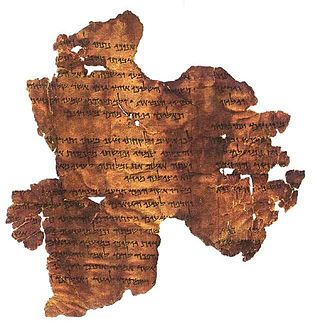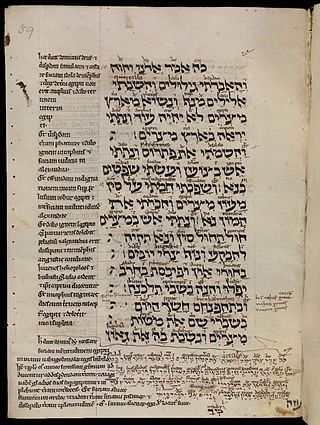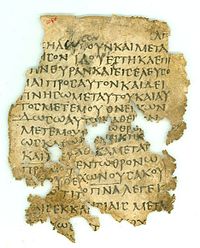
Revelation 1 is the first chapter of the Book of Revelation or the Apocalypse of John in the New Testament of the Christian Bible. The book is traditionally attributed to John the Apostle, but the precise identity of the author is a point of academic debate. This chapter contains the prologue of the book, followed by the vision and commission of John.

Revelation 12 is the twelfth chapter of the Book of Revelation or the Apocalypse of John in the New Testament of the Christian Bible. The book is traditionally attributed to John the Apostle, but the precise identity of the author remains a point of academic debate. This chapter contains the accounts about the woman, the dragon, and the child, followed by the war between Michael and the dragon, then the appearance of the monster from the sea. William Robertson Nicoll, a Scottish Free Church minister, suggests that in this chapter the writer has created a Christianised version of a Jewish source which "described the birth of the Messiah in terms borrowed from ... cosmological myths [such as] that of the conflict between the sun-god and the dragon of darkness and the deep".

Acts 8 is the eighth chapter of the Acts of the Apostles in the New Testament of the Christian Bible. It records the burial of Stephen, the beginnings of Christian persecution, and the spread of the Gospel of Jesus Christ to the people of Samaria and Meroe. The book containing this chapter is anonymous, but early Christian tradition uniformly affirmed that Luke composed this book as well as the Gospel of Luke.

1 Thessalonians 5 is the fifth chapter of the First Epistle to the Thessalonians in the New Testament of the Christian Bible. It is authored by Paul the Apostle, likely written in Corinth in about 50-51 CE for the church in Thessalonica. This chapter contains a message about Christ's second coming, and various final exhortations and greetings.

Revelation 2 is the second chapter of the Book of Revelation or the Apocalypse of John in the New Testament of the Christian Bible. The book is traditionally attributed to John the Apostle, but the precise identity of the author remains a point of academic debate. This chapter contains messages to churches of Ephesus, Smyrna, Pergamum and Thyatira, four of the seven churches of Asia located in modern-day Turkey, with messages for the other three churches appearing in chapter 3.

Revelation 4 is the fourth chapter of the Book of Revelation or the Apocalypse of John in the New Testament of the Christian Bible. The book is traditionally attributed to John the Apostle, but the precise identity of the author remains a point of academic debate. This chapter contains an inaugural vision of heaven, portraying the throne room of heaven, and the heavenly worship which the writer observes there.

Revelation 5 is the fifth chapter of the Book of Revelation or the Apocalypse of John in the New Testament of the Christian Bible. The book is traditionally attributed to John the Apostle, but the precise identity of the author remains a point of academic debate. This chapter contains the inaugural vision of the lamb on the throne in heaven.

Revelation 7 is the seventh chapter of the Book of Revelation or the Apocalypse of John in the New Testament of the Christian Bible. The book is traditionally attributed to John the Apostle, but the precise identity of the author remains a point of academic debate. Chapter 6 to Chapter 8:5 record the opening of the Seven Seals. This chapter contains the writer's vision of "the Four Angels of the Four Winds", the sealing of the 144,000 and the "Praise of the Great Multitude of the Redeemed". The passage in this chapter is 'an intercalation in the numbered series of seven'.

Revelation 11 is the eleventh chapter of the Book of Revelation or the Revelation of Jesus Christ shown to John in the New Testament of the Christian Bible. The book is traditionally attributed to John the Apostle, but the precise identity of the author remains a point of academic debate. This chapter contains the accounts related to the sounding of the "Seventh Trumpet".

Revelation 14 is the fourteenth chapter of the Book of Revelation or the Apocalypse of John in the New Testament of the Christian Bible. The book is traditionally attributed to John the Apostle, but the precise identity of the author remains a point of academic debate. This chapter contains the accounts of the lamb with 144,000 followers, the three angelic messages and the voice from heaven, as well as the harvest of the earth and the vintage of the earth. The Three Angels' messages in verses 6 to 12 form a central feature of the teaching and mission of the Seventh-day Adventist Church: "“Make disciples of Jesus Christ who live as His loving witnesses and proclaim to all people the everlasting gospel of the Three Angels’ Messages in preparation for His soon return".

Revelation 15 is the fifteenth chapter of the Book of Revelation or the Apocalypse of John in the New Testament of the Christian Bible. The book is traditionally attributed to John the Apostle, but the precise identity of the author remains a point of academic debate. This chapter includes the hymn of Moses and the Lamb and introduces the seven angels who appear with seven plagues.

Revelation 17 is the seventeenth chapter of the Book of Revelation or the Apocalypse to John in the New Testament of the Christian Bible. The book is traditionally attributed to John the Apostle, but the precise identity of the author remains a point of academic debate. This chapter describes the judgment of the Whore of Babylon.

Revelation 18 is the eighteenth chapter of the Book of Revelation or the Apocalypse of John in the New Testament of the Christian Bible. The book is traditionally attributed to John the Apostle, but the precise identity of the author remains a point of academic debate. This chapter describes the fall of Babylon the Great.

Revelation 20 is the twentieth chapter of the Book of Revelation or the Apocalypse of John in the New Testament of the Christian Bible. The book is traditionally attributed to John the Apostle, but the precise identity of the author remains a point of academic debate. This chapter contains the notable account of the "Millennium" and the judgment of the dead.

Revelation 19 is the nineteenth chapter of the Book of Revelation or the Apocalypse of John in the New Testament of the Christian Bible. The book is traditionally attributed to John the Apostle, but the precise identity of the author remains a point of academic debate. In this chapter, heaven exults over the fall of Babylon the Great.

Revelation 21 is the twenty-first chapter of the Book of Revelation in the New Testament of the Christian Bible. This chapter contains the accounts of "the new heaven and the new earth", followed by the appearance of the New Jerusalem the Bride.

Revelation 22 is the twenty-second and final chapter of the Book of Revelation or the Apocalypse of John, and the final chapter of the New Testament and of the Christian Bible. The book is traditionally attributed to John the Apostle. This chapter contains the accounts of the throne of God in the New Jerusalem, the conversation between John and the Angel and the epilogue of the book.

Hosea 2 is the second chapter of the Book of Hosea in the Hebrew Bible or the Old Testament of the Christian Bible. This book contains the prophecies attributed to the prophet Hosea son of Beeri and this chapter contains the application of the symbols in the first chapter. It is a part of the Book of the Twelve Minor Prophets.

Hosea 13 is the thirteenth chapter of the Book of Hosea in the Hebrew Bible or the Old Testament of the Christian Bible. The book contains the prophecies attributed to the prophet Hosea son of Beeri. This chapter and the next one may belong to the troubled times that followed Pekah's murder by Hoshea. The subject is the idolatry of Ephraim, notwithstanding God's past benefits, destined to be his ruin. It is a part of the Book of the Twelve Minor Prophets.

Ezekiel 44 is the forty-fourth chapter of the Book of Ezekiel in the Hebrew Bible or the Old Testament of the Christian Bible. This book contains the prophecies attributed to the prophet/priest Ezekiel, and is one of the Books of the Prophets. The final section of Ezekiel, chapters 40-48, give the ideal picture of a new temple. The Jerusalem Bible refers to this section as "the Torah of Ezekiel". In particular, chapters 44–46 record various laws governing the rites and personnel of the sanctuary, as a supplement to Ezekiel's vision.
















